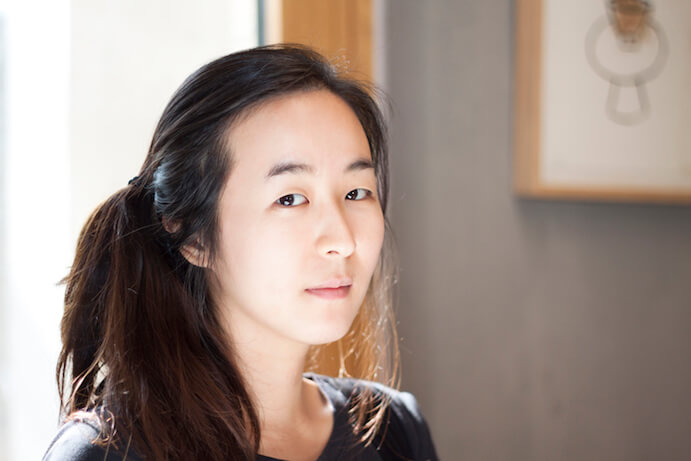“We like to call this MATA masala,” said Executive Director Todd Tarantino of “Neither Land, Nor Sea, Nor Air,” and he got that partly right. MATA’s April 15, 2016 concert did serve a satisfying program – but unlike chicken tikka masala, there was no confusion about its origins. Seven performers gave US premieres to six international works that deserved their place in MATA’s annual showcase of distinct new music.
Roasted bass clarinet sounds opened the program. Against an electronic backdrop of gongs and distant tin, Carlos Cordeiro rolled through Time In & Out’s roster of extended techniques and created an entire railroad of sound. He ducked low and swung high in peals of non-trills, shifting like a mountain goat between loose sounds. Composer Germán Alonso (Spain) gave his piece self-possession within freewheeling; the electronics provided a steady pulse for most of the work. Near the piece’s end, Cordeiro cycled on a motif of four pulsing signals and four scurrying runs before giving a sudden melodic vintage of jazz legend Eric Dolphy. Cordeiro’s clarinet clamored past and left the audience in the twilight of electronic fade.
Zhou Qian (China) also set an unusual instrument within a saturated electronic environment. Qu Shui Ming Yun (2016 Qin Version) was first written for the guzheng, but use of the contemplative qin augmented sudden bursts of aggression in the piece. Instrumentalist Yi Zhou performed the micro-movements with a liquid wrist and purposed fingertips, except when her fingernails raked the strings in forceful qin technique. The piece meandered through microtones and sonic decay without establishing a melodic pathway; Qian’s piece allowed the audience to savor the unfamiliar qin timbre with a sense of unpatterned time. As recorded sounds built a cosmopolitan sanctuary, the qin was sometimes overtaken by its electroacoustic environment and it looked like Yi Zhou was producing the electronics in a striking hybrid of tradition and modernity.
Nicolai Worsaae– Photo By Bjarke Ørsted
In an interview before the next piece, composer Nicolai Worsaae (Denmark) highlighted the sinister nature of Upon your body I’m crawling. Although the title was his starting point, Worsaae already had in mind the Italian legend of the tarantella dance, that one could dance out poison from a spider bite. The title’s key word was “upon”, an innocent preposition colored by force. Demanding constant playing from accordionist William Schimmel in a harmonica neck holder, the composition acted upon his body and breath. It acted upon the accordion by exposing its weakest functions and, like the tarantella’s use of dance near death, Upon your body I’m crawling acted upon the accordion’s joyful tradition and made it an agent of forced consent. But Schimmel turned his own agency upon the macabre composition, and gave a spectacular comic performance. In character from the moment he entered the audience’s view, Schimmel struggled to prepare his instruments, couldn’t find a place for his glasses, and grew more cantankerous with every page of completed music he threw on the floor. He wheezed, huffed, and rested so humorously that the piece’s cruelty was disarmed, and the drama was so engaging that his sudden full-bodied yells were shocking. In such stark contrast to his comedy, Schimmel’s frantic rhythms and loud vocal protests returned the piece to its origins of troubled consent.
Mátyás Wettl– Photo by Dennis Khieffer Beviz
After intermission, Mátyás Wettl (Hungary) elevated the indie-ballad formula through subtle substitutions and electronic additions in Unusual. In place of strummed acoustic guitar, a classical guitar in the hands of Dan Lippel played a melodic bossa nova. In place of easy language, limited melodic range, and nasal vowels, Eliza Bagg’s soprano lingered over poetry and soared in wide intervals. Wettl’s composition replaced formulaic common tempo with proportional notation, and added three pre-recorded guitar tracks improvised in real time by Sam Pluta. This electronic addition neither weakened the form’s familiarity nor increased its tension; even when all three pre-recorded guitars were activated, they never dominated Lippel’s live guitar. Eliza Bagg’s soprano was the pure embodiment of the text she sang: “purple kite floats in the sky … I think I might have changed / throughout the time.”
Unusual’s sophisticated comfort was a welcome respite before Sabina Ahn’s unsettling Breath. Interested in transforming data into other shapes and sounds, Ahn (South Korea) converted her breath into light, sound, and something dangerous. Four small boxed bulbs flickered when powered by her breath, and would have seemed like candles had not Ahn’s breath also been converted into threatening electrical sounds that charged the space. As the source of these environmental byproducts, her simple exhales became the most threatening element of the piece. Every breath became more suspenseful, and the audience’s attention was held to the moment of conversion despite an immersive environment. Ahn emerged from the mixed media a triumphant composer, having remained focused on sound, organization, and effect.
Breath from Sabina Ahn on Vimeo.
The program finished with Re-Pulse, a brash oboe-accordion duet by Maxim Kolomiiets (Ukraine). Inside structural simplicity, Stuart Breczinski’s oboe and William Schimmel’s accordion were mostly concerned with their own caloric output. They plunged beyond traditional melodies into extreme outlines but stayed unified in stamina, taking moments to re-charge before they were at it again. Occasionally tossing a shape to the other, the jocular spark between the two performers channeled the drama and momentum of the program to a satisfying conclusion. “Neither Sea, Nor Land, Nor Air” deeply involved its audience without external references. By presenting sound collections of high and equal caliber, the program evoked many associations but existed independent of their meaning. The program neither forced immersion nor avoided depth; it simply partnered humans, objects, and time to act upon the audience’s space of being.

